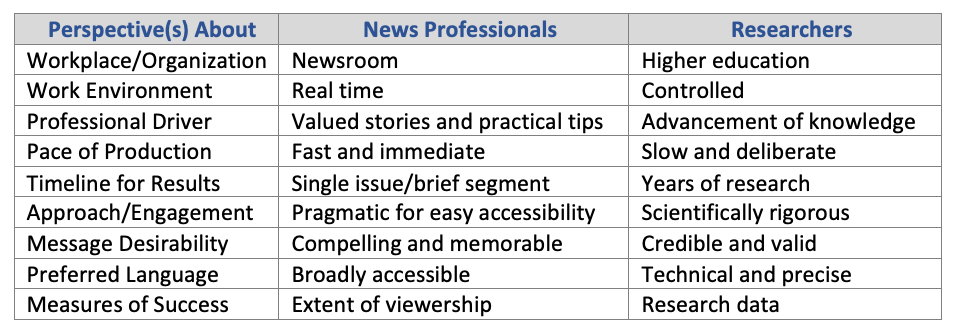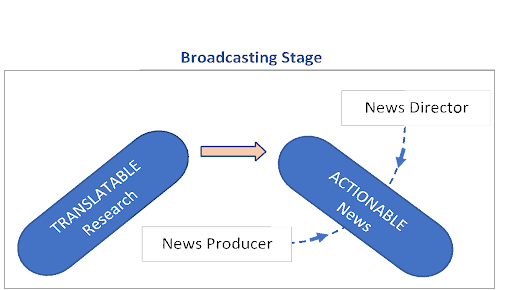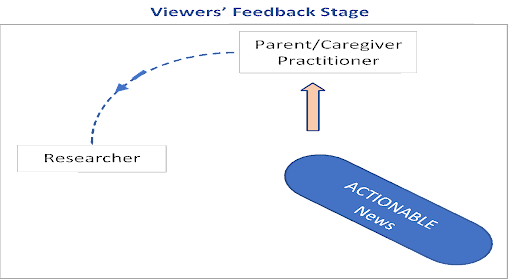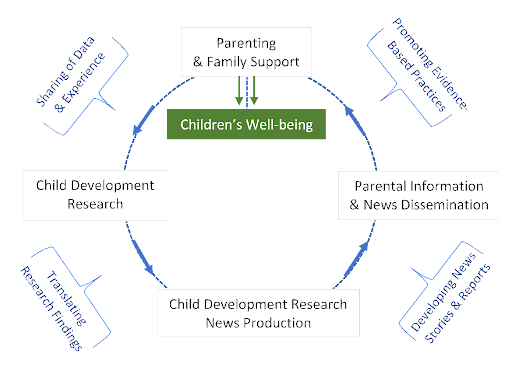At the Nexus of Social Science Research and Consumable News: Observations from the Child Trends News Service
This blog was written by Principals of Group i&i Consultancy, who serve as the External Review Team for the Child Trends News Service project.
Introduction
The Child Trends News Service (CTNS) produces research-based news designed for public consumption. In 2022, Child Trends is concluding the final year of a Phase II award (#1811007) from the National Science Foundation’s (NSF’s) Advancing Informal STEM Learning Program for Innovations in Development. This award was preceded by a Phase I (#1612747) two-year proof-of-concept study initiated in August 2016, a research-and-dissemination effort accompanied by extensive formative research and an impact study design. Phase II was an impact study that built upon significant Phase I accomplishments, including foundational collaborative relationships developed with the CTNS partnering production company, Ivanhoe Broadcast News, and members of the Project’s Advisory Panel. In Year 1 of Phase II, the CTNS newsfeed was rebranded as the “Positive Parenting Newswire.”
The award funded a project called Advancing Social Science Knowledge to Benefit Hispanic Families , a key objective of which is to effectively translate rigorous child development research into consumable news with practical tips for parents and teachers. The TV news segments consist of 60–90-second narrated reports in both English and Spanish that feature actionable research pertinent to parenting. More than 300 news segments have been produced to date, and the reports have been broadcast through 364 unique TV stations in leading U.S. TV markets, amassing an estimated average of 46 million views per report. Given the steady and growing popularity of TV news in specific markets, including those serving Hispanic populations, these results make a compelling case for the CTNS to focus on TV news as the primary vehicle for dissemination.
The CTNS operates at the intersection of communication science, social science, and TV news through an established collaboration between Child Trends, a leading research organization focused on improving the lives of children and families, and Ivanhoe Broadcast News (IBN), a leading national news syndicate. The overall project is also supported by an advisory panel of researchers, experts, and thought leaders.
Exploring the Research-into-News Translational Process
The External Review Team examined the interface between research and news, a key facet of the CTNS, searching for unique features and characteristics of success and barriers. This examination included extensive interviews with various constituents—individually and in focus groups—and a detailed review of the production process, from story identification to broadcasting. The findings from this effort, to be refined over time, can deepen the understanding of how social science research can advance public STEM learning, particularly through TV news, and how it might be replicated in other STEM areas. The aim was to address a larger question at the center of the CTNS’ work: What would it take to translate rigorous child development research effectively into TV news segments ready for public consumption—segments that capture the viewers’ attention and inform, as well as influence, behavior?
An Emerging Framework
Equipped with data about the news segments’ effects on viewers’ knowledge, attitude, and behavior, the Review Team carefully considered the CTNS’ process. The goal was to learn how to turn research findings into news stories that stir interest among viewers, disseminate knowledge about child development and parenting, and share applicable research-informed tips urging parents to act or act differently. The framework that emerged recognizes the need in any research-to-news production effort to (a) cross the cultural bridge between researchers and media news directors; and (b) ensure that integrity of research is balanced with usefulness and accessibility of news segments. The CTNS project addressed differing needs of researchers and news directors, accounted for contrasting characteristics of news stories and research articles, and safeguarded the independent journalistic elements of what constitutes objective news, compared with research-informed advocacy.
Crossing the Cultural Bridge. Interviews with researchers, news directors, and the news producer/syndicator revealed contextual differences in interest and perspectives (presented in the table below) between how news professionals and researchers understand their work and approach their communications.

Following the Path from Shared Research to Viewed News. The pathway from research to TV news—and, ultimately, to opportunities for enhanced parental learning and children’s development—follows three consecutive, and somewhat iterative, developmental stages, which can be generalized beyond the CTNS experience: I. Design & Production; II. Dissemination; and III. Viewers’ Engagement.
I. Design & Production. This is a front-end stage that involves various stakeholders in important tasks and collaborative responsibilities:
- The coordinating team (here, Child Trends), which identifies, selects, and vets, or ensures the proper vetting of, rigorous research to be featured in stories about relevant contemporary societal issues, and recent publications of studies making practical suggestions to parents about ways to enhance child development.
- The researcher, who, as author of a published study, brings deep knowledge about a topic, advises, may be featured in the video, and is commonly concerned about the rigor of the study, accuracy of the message, and scholarly reputation.
- The news producer/syndicator, who is responsible for independently producing the segment, focused on the needs of news directors (in this case, TV news) for reliable, constantly piped newsfeed and stories, journalistic independence, and accessibility of the message to the ultimate viewers.
II. Dissemination. This is an intermediate stage through which the news producer/syndicator (here, IBN) makes the completed STEM news segments available to the news directors to be aired on TV news programs and through other media platforms.
The news production company sends videos to the news directors, who then have the flexibility to add voice-over or customizable messaging. Regular feedback is then gathered from the news directors by the syndicate to assess which themes work well or which may not. Based on the level of continued demand and topic-related feedback for additional segments from the news directors, the producer is then able to make adjustments and recommendations that may inform subsequent production.

III. Viewers’ Engagement Stage. This is the public-facing end-stage through which consumers (parents or caregivers in this project) watch the news videos, via TV or online through their preferred local stations. Viewers then process the information received, potentially resulting in new awareness, decisions, or actions designed to enhance parenting/guidance that could positively impact the growth of their children.
In the case of the CTNS, some parents and caregivers also interfaced with practitioners directly and benefited (through them or independently) from the produced video segments. This is where critical feedback comes in from parents to the researchers, as shown in the next diagram (and in the consolidated cycle of influence presented later in the research-to-news criteria diagram).

The diagrams above represent complex interrelationships and communications pathways between and among multiple organizations and sectors (across disciplines) required to effectively translate social science research into consumable, actionable news focused on the outcomes of “children’s enhanced wellbeing,” the ultimate vision of this effort.
An Emerging Cycle of Influence & Impact. In-depth conversations with all stakeholders, and a subsequent review of the summative research conducted by the CTNS with viewers, shed light on the elements required for research to be effectively translated into actionable news within the context of the backbone organization (in this case, the CTNS). The next diagram captures the criteria for success required to effectively consider the needs of all stakeholders and ensure process integrity.

The CTNS cycle of influence (informed by the review and made generic for replicability) is presented in the next diagram, showing the continuous flow from parents’ child-rearing data to research findings, and from actionable news to parents’ responses. This is a distributed, multi-nodal network with no individual or entity specifically controlling or fully coordinating each exchange.

This simplified cycle illustrates how the research news segments inform parents about the latest trends and evidence-based practices and inspire them to adopt beneficial behavior (i.e., by building parental awareness and valued knowledge, these short news reports may facilitate new behaviors). Bringing the various players into the picture and emulating the CTNS experience adds greater complexity and clarity to the process in terms of areas of collaboration, lines of communication, and learning loops. (A deeper-level framework, with all stakeholders involved, is not presented here; to see more, please contact info@Groupi-i.com.)
Conclusion and Recommendations
Disseminating vetted results of STEM studies and discoveries within the broader lay community has always been a key part of the scientific process. It represents a significant, responsible undertaking that contributes to broader societal impact. In essence, this is the driving force behind the CTNS, which is now well-positioned as a resource for child development communities of research and practice at large.
More and more researchers and research centers endeavor to translate their research for public sharing, often with the assistance of PR teams. In today’s era of video and social-media communication, in particular, researchers are invited (and urged) to present their work to the public, once it has been assessed and accepted through the peer-review process, in bite-sized chunks. Instead of researchers, institutions, or centers taking a piecemeal, localized approach, STEM-based professional societies or funding agencies may have an important media-facing role to play in launching the sort of news feeds that build on what has been learned from this project. Among the lessons learned from the CTNS project is that other societies or agencies might consider, in their advocacy roles, developing and disseminating ongoing series of video news segments that communicate the latest news about STEM research published by their members or grantees in ways that are accessible and applicable to the lay community and larger society.